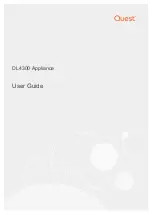
DS300f G2 Series User Manual
196
loss.
A
dvAnced
b
Attery
f
lAsh
b
AckuP
This feature uses power from the BBU to save the write cache used for the RAID controller to NAND flash
memory. When the write chache data backup is complete, the remaining BBU ceases to supply power for the
write cache and the remaining battery capacity is conserved. This in effect, indefinitely extends the period of
write loss protection beyond the required 72 hours typical for most BBU setups.
P
referreD
c
ontroller
ID
P
ower
S
avInG
Power saving is a method of
conserving energy by applying specific actions to hard disk drives (HDD). After an
HDD has been idle for the set period of time, you can elect to:
•
Park the read/write heads – Referred to as
Power Saving Idle Time
on ASUS DS300f G2.
•
Reduce disk rotation speed – Referred to as
Power Saving Standby Time
on ASUS DS300f G2.
•
Spin down the disk (stop rotation) – Referred to as
Power Saving Stopped Time
on ASUS DS300f G2.
Power management must be:
•
Set on the RAID controller. see "Making Controller Settings (CLU)" on page <?>.
•
Enabled on each HDD.
c
aPacIty
c
oercIon
This feature is designed for fault-tolerant logical drives (RAID 1, 1E, 5, 10, 50, and 60). It is generally recommended
to use physical drives of the same size in your disk arrays. When this is not possible, the system adjusts for the
size differences by reducing or coercing the capacity of the larger drives to match the smaller ones. With ASUS
DS300f G2, you can choose to enable capacity coercion and any one of four methods.
Enable capacity coercion and choose a method, see "Making Controller Settings (CLU)" on page <?>. The
choices are:
•
GB Truncate – (Default) Reduces the useful capacity to the nearest 1,000,000,000 byte boundary.
•
10GB Truncate – Reduces the useful capacity to the nearest 10,000,000,000 byte boundary.
•
Group Rounding – Uses an algorithm to determine how much to truncate. Results in the maximum amount
of usable drive capacity.
• Table Rounding
– Applies a predefined table to determine how much to truncate.
Capacity coercion also affects a replacement drive used in a disk array. Normally, when an physical drive fails,
the replacement drive must be the same capacity or larger. However, the capacity coercion feature permits the
installation of a replacement drive that is slightly smaller (within 1 gigabyte) than the remaining working drive.
For example, the remaining working drives can be 80.5 GB and the replacement drive can be 80.3, since all are
rounded down to 80 GB. This permits the smaller drive to be used.
Without capacity coercion, the controller does not permit the use of a replacement physical drive that is slightly
smaller than the remaining working drives.
Содержание DS300 G2 Series
Страница 1: ...ASUS Storage DS300 G2 Series ...
Страница 11: ......
Страница 34: ......
Страница 38: ......
Страница 262: ......
















































